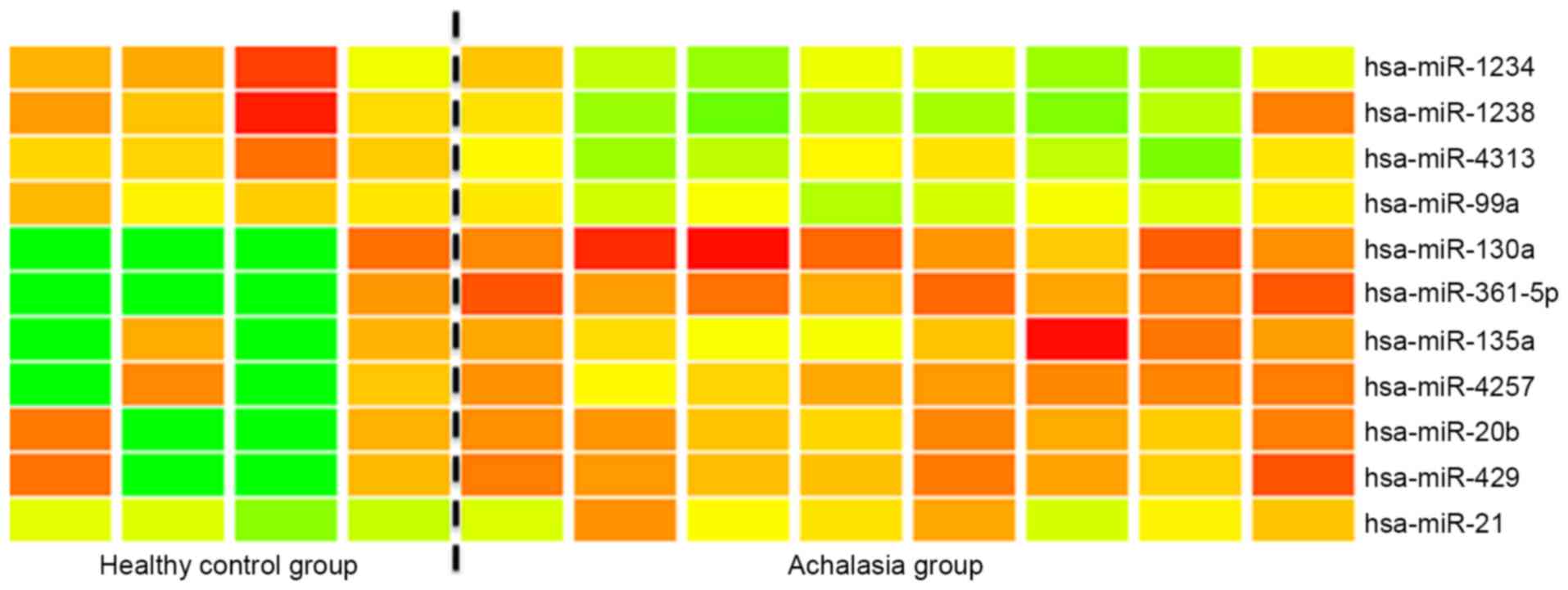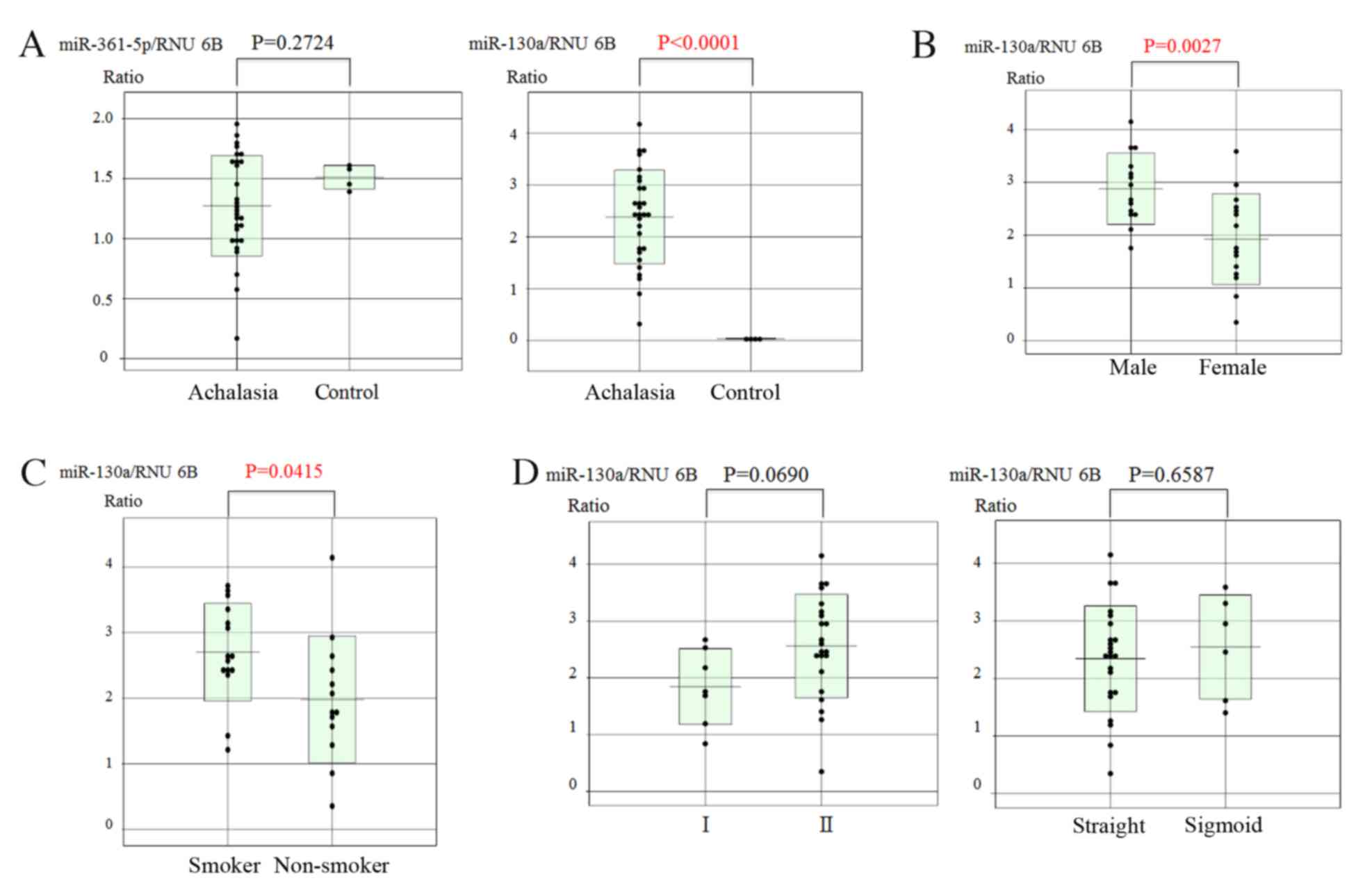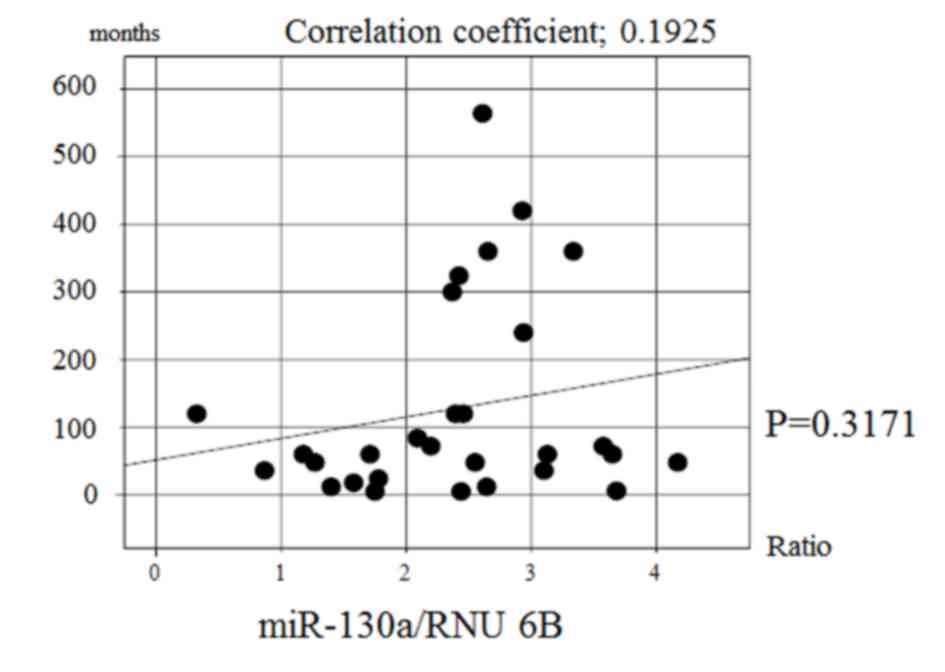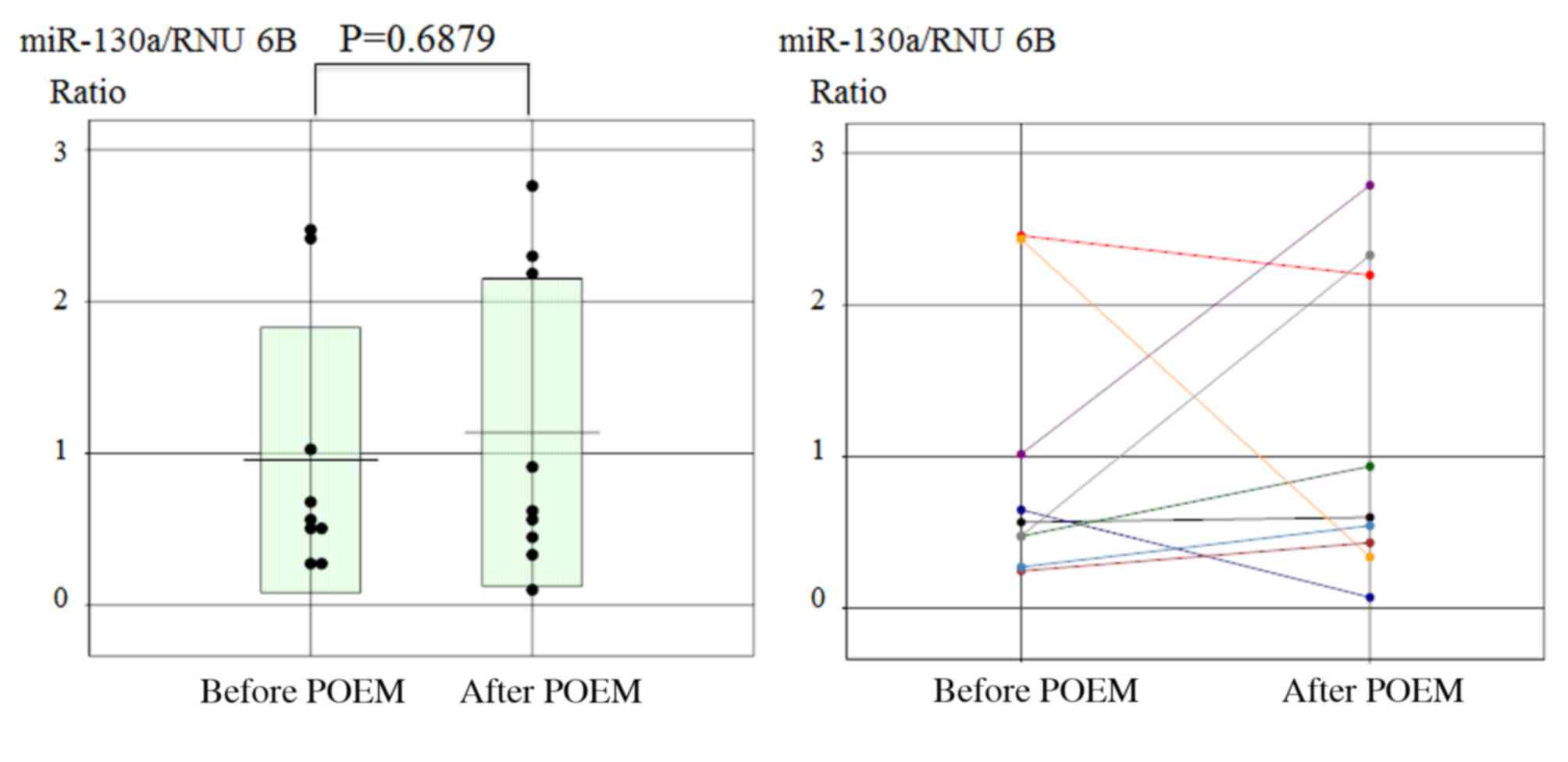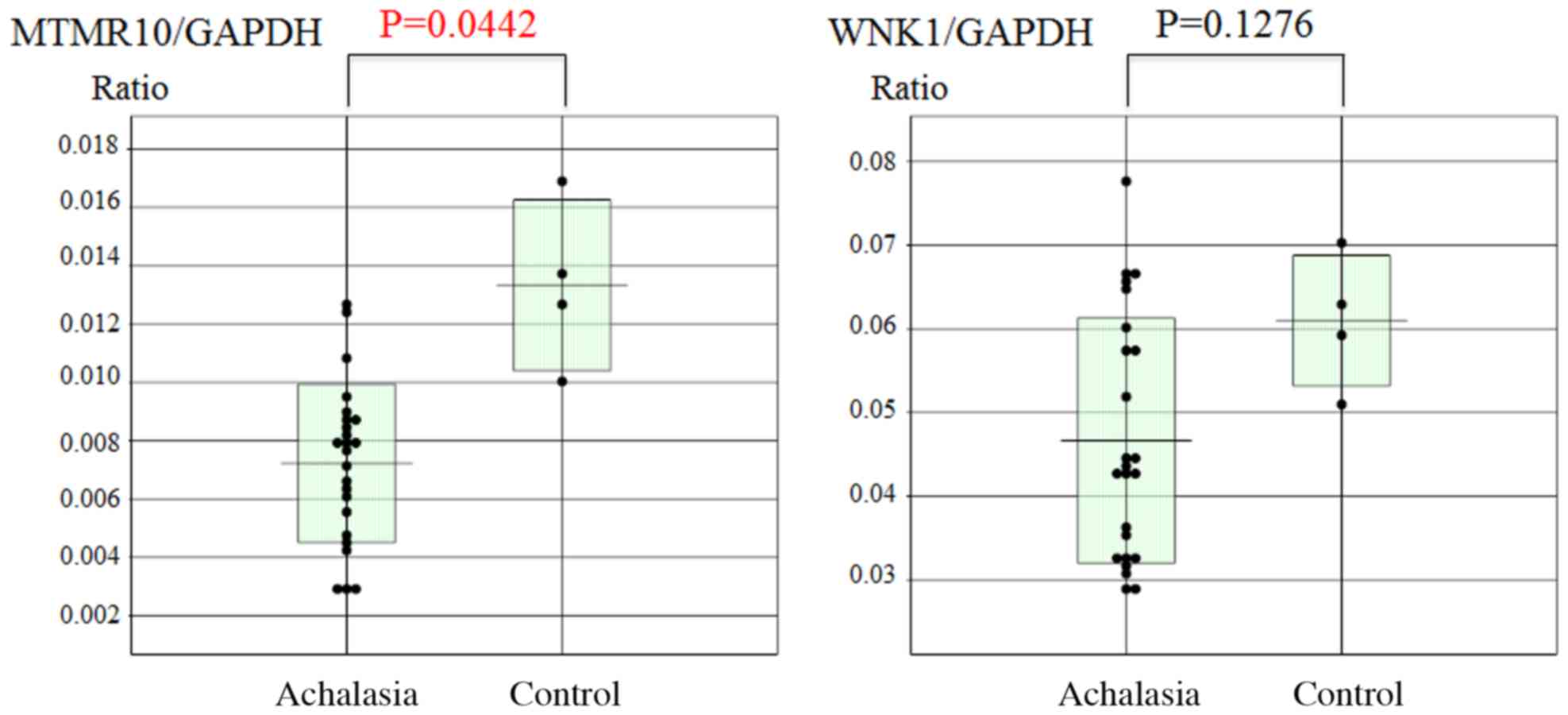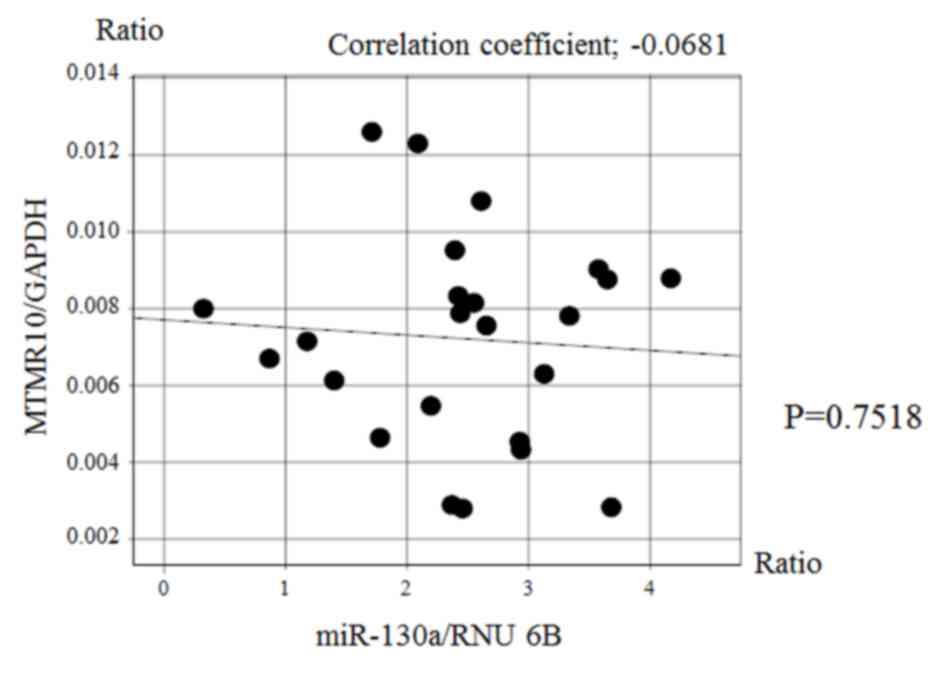|
1
|
Leeuwenburgh I, Scholten P, Alderliesten
J, Tilanus HW, Looman CW, Steijerberg EW and Kuipers EJ: Long-term
esophageal cancer risk in patients with primary achalasia: A
prospective study. Am J Gastroenterol. 105:2144–2149. 2010.
View Article : Google Scholar : PubMed/NCBI
|
|
2
|
Gockel I, Muller M and Schumacher J:
Achalasia-a disease of unknown cause that is often diagnosed too
late. Dtsch Arztebl Int. 109:209–214. 2012.PubMed/NCBI
|
|
3
|
Zendehdel K, Nyrén O, Edberg A and Ye W:
Risk of esophageal adenocarcinoma in achalasia patients, a
retrospective cohort study in Sweden. Am J Gastroenterol.
106:57–61. 2011. View Article : Google Scholar : PubMed/NCBI
|
|
4
|
Meijssen MA, Tilanus HW, van Blankenstein
M, Hop WC and Ong GL: Achalasia complicated by esophageal squamous
cell carcinoma: A prospective study in 195 patients. Gut.
33:155–158. 1992. View Article : Google Scholar : PubMed/NCBI
|
|
5
|
Porschen R, Molsberger G, Kühn A, Sarbia M
and Borchard F: Achalasia-associated squamous cell carcinoma of the
esophagus: Flow-cytometric and histological evaluation.
Gastroenterology. 108:5455491995. View Article : Google Scholar
|
|
6
|
Streitz JM Jr, Ellis FH Jr, Gibb SP and
Heatley GM: Achalasia and squamous cell carcinoma of the esophagus:
Analysis of 241 patients. Ann Thorac Surg. 59:1604–1609. 1995.
View Article : Google Scholar : PubMed/NCBI
|
|
7
|
West RL, Hirsch DP, Bartelsman JF, de
Borst J, Ferwerda G, Tytqat GN and Boeckxstaens GE: Long term
results of pneumatic dilation in achalasia followed for more than 5
years. Am J Gastroenterol. 97:1346–1351. 2002. View Article : Google Scholar : PubMed/NCBI
|
|
8
|
Minami H, Yamaguchi N, Matsushima K,
Akazawa Y, Ohnita K, Takeshima F, Nakayama T, Hayashi T, Inoue H,
Nakao K and Isomoto H: Improvement of endocytoscopic findings after
per oral endoscopic myotomy POEM) in esophageal achalasia; does
POEM reduce the risk of developing esophageal carcinoma? Per oral
endoscopic myotomy, endocytoscopy and carcinogenesis. BMC
Gastroenterol. 13:222013. View Article : Google Scholar : PubMed/NCBI
|
|
9
|
Campos GM, Vittinqhoff E, Rabl C, Takata
M, Gadenstätter M, Lin F and Ciovica R: Endoscopic and surgical
treatments for achalasia: A systematic review and meta-analysis.
Ann Surg. 249:45–57. 2009. View Article : Google Scholar : PubMed/NCBI
|
|
10
|
Inoue H, Minami H, Kobayashi Y, Sato Y,
Kaga M, Suzuki M, Satodate H, Okada N, Itoh H and Kudo S: Peroral
endoscopic myotomy (POEM) for esophageal achalasia. Endoscopy.
42:265–271. 2010. View Article : Google Scholar : PubMed/NCBI
|
|
11
|
Minami H, Isomoto H, Yamaguchi N,
Matsushima K, Akazawa Y, Ohnita K, Takeshima F, Inoue H and Nakao
K: Peroral endoscopic myotomy for esophageal achalasia: Clinical
impact of 28 cases. Dig Endosc. 26:43–51. 2014. View Article : Google Scholar : PubMed/NCBI
|
|
12
|
Matsushima K, Isomoto H, Yamaguchi N,
Inoue N, Machida H, Nakayama T, Hayashi T, Kunizaki M, Hidaka S,
Nagayasu T, et al: MiRNA-205 modulates cellular invasion and
migration via regulating zinc finger E-box binding homeobox 2
expression in esophageal squamous cell carcinoma cells. J Transl
Med. 9:302011. View Article : Google Scholar : PubMed/NCBI
|
|
13
|
Carthew RW and Sontheimer EJ: Origins and
Mechanisms of miRNAs and siRNAs. Cell. 136:642–655. 2009.
View Article : Google Scholar : PubMed/NCBI
|
|
14
|
Schmittgen TD: Regulation of microRNA
processing in development, differentiation and cancer. J Cell Mol
Med. 12:1811–1819. 2008. View Article : Google Scholar : PubMed/NCBI
|
|
15
|
Rosenfeld N, Aharonov R, Meiri E,
Rosenwald S, Spector Y, Zepeniuk M, Benjamin H, Shabes N, Tabak S,
Levy A, et al: MicroRNAs accurately identify cancer tissue origin.
Nat Biotechnol. 26:462–469. 2008. View
Article : Google Scholar : PubMed/NCBI
|
|
16
|
Liang Y, Ridzon D, Wong L and Chen C:
Characterization of microRNA expression profiles in normal human
tissues. BMC Genomics. 8:1662007. View Article : Google Scholar : PubMed/NCBI
|
|
17
|
Croce CM: Causes and consequences of
microRNA dysregulation in cancer. Nat Rev Genet. 10:704–714. 2009.
View Article : Google Scholar : PubMed/NCBI
|
|
18
|
Mathé EA, Nguyen GH, Bowman ED, Zhao Y,
Budhu A, Schetter AJ, Braun R, Reimers M, Kumamoto K, Hughes D, et
al: MicroRNA expression in squamous cell carcinoma and
adenocarcinoma of the esophagus: Associations with survival. Clin
Cancer Res. 15:6192–6200. 2009. View Article : Google Scholar : PubMed/NCBI
|
|
19
|
Feber A, Xi L, Luketich JD, Pennathur A,
Landreneau RJ, Wu M, Swanson SJ, Godfrey TE and Litle VR: MicroRNA
expression profiles of esophageal cancer. J Thorac Cardiovasc Surg.
135:255–260. 2008. View Article : Google Scholar : PubMed/NCBI
|
|
20
|
Lebanony D, Benjamin H, Gilad S, Ezagouri
M, Dov A, Ashkenazi K, Gefen N, Izraeli S, Rechavi G, Pass H, et
al: Diagnostic assay based on I-miR-205 expression distinguishes
squamous from nonsquamous non-small-cell lung carcinoma. J Clin
Oncol. 27:2030–2037. 2009. View Article : Google Scholar : PubMed/NCBI
|
|
21
|
Kimura S, Naganuma S, Susuki D, Hirono Y,
Yamaguchi A, Fujieda S, Sano K and Itoh H: Expression of microRNAs
in squamous cell carcinoma of human head and neck and the
esophagus: miR-205 and miR-21 are specific markers for HNSCC and
ESCC. Oncol Rep. 23:1625–1633. 2010.PubMed/NCBI
|
|
22
|
Smith CM, Michael MZ, Watson DI, Tan G,
Astill DS, Hummel R and Hussey DJ: Impact of gastro-oesophageal
reflux on microRNA expression, location and function. BMC
Gastroenterol. 13:42013. View Article : Google Scholar : PubMed/NCBI
|
|
23
|
Leeuwenburgh I, Haringsma J, Van Dekken H,
Scholten P, Siersema PD and Kuipers EJ: Long-term risk of
oesophagitis, Barrett's oesophagus and oesophageal cancer in
achalasia patients. Scand J Gastroenterol. Suppl 7–10:2006.
View Article : Google Scholar
|
|
24
|
Descriptive Rules for Achalasia of the
Esophagus. 4th. Japan Society of Esophageal Diseases, Kanehara
& Co., Ltd.; Tokyo: 2012
|
|
25
|
Matsui N, Akahoshi K, Nakamura K, Ihara E
and Kita H: Endoscopic submucosal dissection for removal of
superficial gastrointestinal neoplasms: A technical review. World J
Gastrointest Endosc. 4:123–136. 2012. View Article : Google Scholar : PubMed/NCBI
|
|
26
|
Gibcus JH, Menkema L, Mastik MF, Hermsen
MA, de Bock GH, van Velthuysen ML, Takes RP, Kok K, Marcos CA
Alvarez, van der Laan BF, et al: Amplicon mapping and expression
profiling identify the Fas-associated death domain gene as a new
driver in the 11q13.3 amplicon in laryngeal/pharyngeal cancer. Clin
Cancer Res. 13:6257–6266. 2007. View Article : Google Scholar : PubMed/NCBI
|
|
27
|
Reshmi SC, Huang X, Schoppy DW, Black RC,
Saunders WS, Smith DI and Gollin SM: Relationship between FRA11F
and 11q13 gene amplification in oral cancer. Genes Chromosomes
Cancer. 46:143–54. 2007. View Article : Google Scholar : PubMed/NCBI
|
|
28
|
Cheng CK, Chow LW, Loo WT, Chan TK and
Chan V: The cell cycle checkpoint gene Rad9 is a novel oncogene
activated by 11q13 amplification and DNA methylation in breast
cancer. Cancer Res. 65:8646–8654. 2005. View Article : Google Scholar : PubMed/NCBI
|
|
29
|
Zheng SL, Stevens VL, Wiklund F, Isaacs
SD, Sun J, Smith S, Pruett K, Wiley KE, Kim ST, Zhu Y, et al: Two
independent prostate cancer risk-associated Loci at 11q13. Cancer
Epidemiol Biomarkers Prev. 18:1815–1820. 2009. View Article : Google Scholar : PubMed/NCBI
|
|
30
|
Chen Y and Gorski DH: Regulation of
angiogenesis through a microRNA (miR-130a) that down-regulates
antiangiogenic homeobox genes GAX and HOXA5. Blood. 111:1217–1226.
2008. View Article : Google Scholar : PubMed/NCBI
|
|
31
|
Boll K, Reiche K, Kasack K, Mörbt N,
Kretzschmar AK, Tomm JM, Verhaegh G, Schalken J, von Bergen M, Horn
F and Hackermüller J: MiR-130a, miR-203 and miR-205 jointly repress
key oncogenic pathways and are downregulated in prostate carcinoma.
Oncogene. 32:277–285. 2013. View Article : Google Scholar : PubMed/NCBI
|
|
32
|
Xu N, Shen C, Luo Y, Xia L, Xue F, Xia Q
and Zhang J: Upregulated miR-130a increases drug resistance by
regulating RUNX3 and Wnt signaling in cisplatin-treated HCC cell.
Biochem Biophys Res Commun. 425:468–272. 2012. View Article : Google Scholar : PubMed/NCBI
|
|
33
|
Yang L, Li N, Wang H, Jia X, Wang X and
Luo J: Altered microRNA expression in cisplatin-resistant ovarian
cancer cells and upregulation of miR-130a associated with
MDR1/P-glycoprotein-mediated drug resistance. Oncol Rep.
28:592–600. 2012.PubMed/NCBI
|
|
34
|
Acunzo M, Visone R, Romano G, Veronese A,
Lovat F, Palmieri D, Bottoni A, Garofalo M, Gasparini P, Condorelli
G, et al: miR-130a targets MET and induces TRAIL-sensitivity in
NSCLC by downregulating miR-221 and 222. Oncogene. 31:634–642.
2012.PubMed/NCBI
|
|
35
|
Shi B, Gao H, Zhang T and Cui Q: Analysis
of plasma microRNA expression profiles revealed different cancer
susceptibility in healthy young adult smokers and middle-aged
smokers. Oncotarget. 7:21676–21685. 2016.PubMed/NCBI
|
|
36
|
Mullany LE, Herrick JS, Wolff RK, Stevens
JR and Slattery ML: Assosiation of cigarette smoking and microRNA
expression in rectal cancer: Insight into tumor phenotype. Cancer
Epidemiol. 45:98–107. 2016. View Article : Google Scholar : PubMed/NCBI
|
|
37
|
Laporte J, Hu LJ, Kretz C, Mandel JL,
Kioschis P, Coy JF, Kluack SM, Poustka A and Dahl N: A gene mutated
in X-linked myotubular myopathy defines a new putative tyrosine
phosphatase family conserved in yeast. Nat Genet. 13:175–182. 1996.
View Article : Google Scholar : PubMed/NCBI
|
|
38
|
Senderek J, Bergmann C, Weber S, Ketelsen
UP, Schorle H, Rudnik-Shöneborn S, Büttner R, Buchheim E and Zerres
K: Mutation of the SBF2 gene, encoding a novel member of the
myotubularin family, in Charcot-Marie-Tooth neuropathy type
4B2/11p15. Hum Mol Genet. 12:349–356. 2003. View Article : Google Scholar : PubMed/NCBI
|















